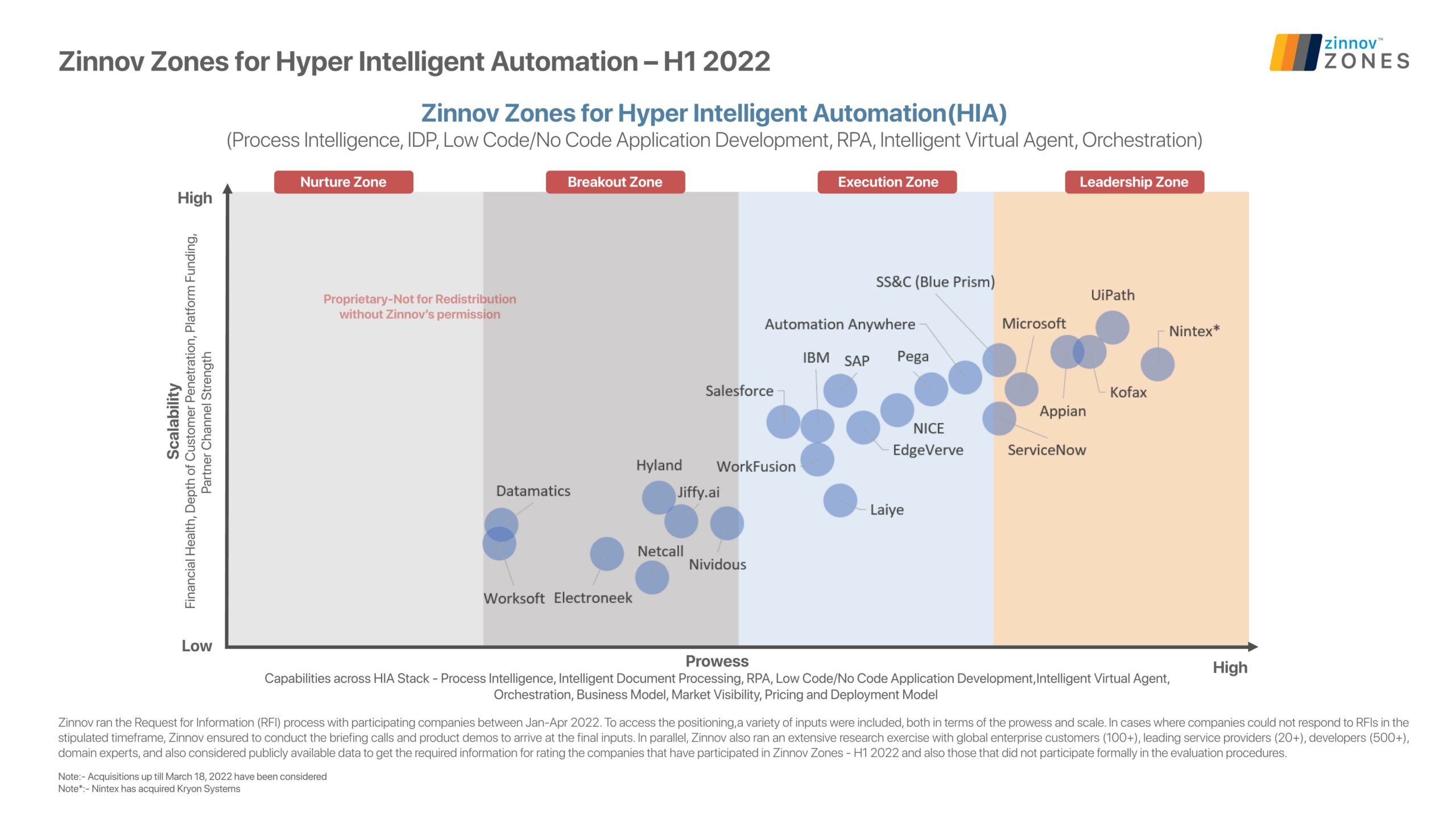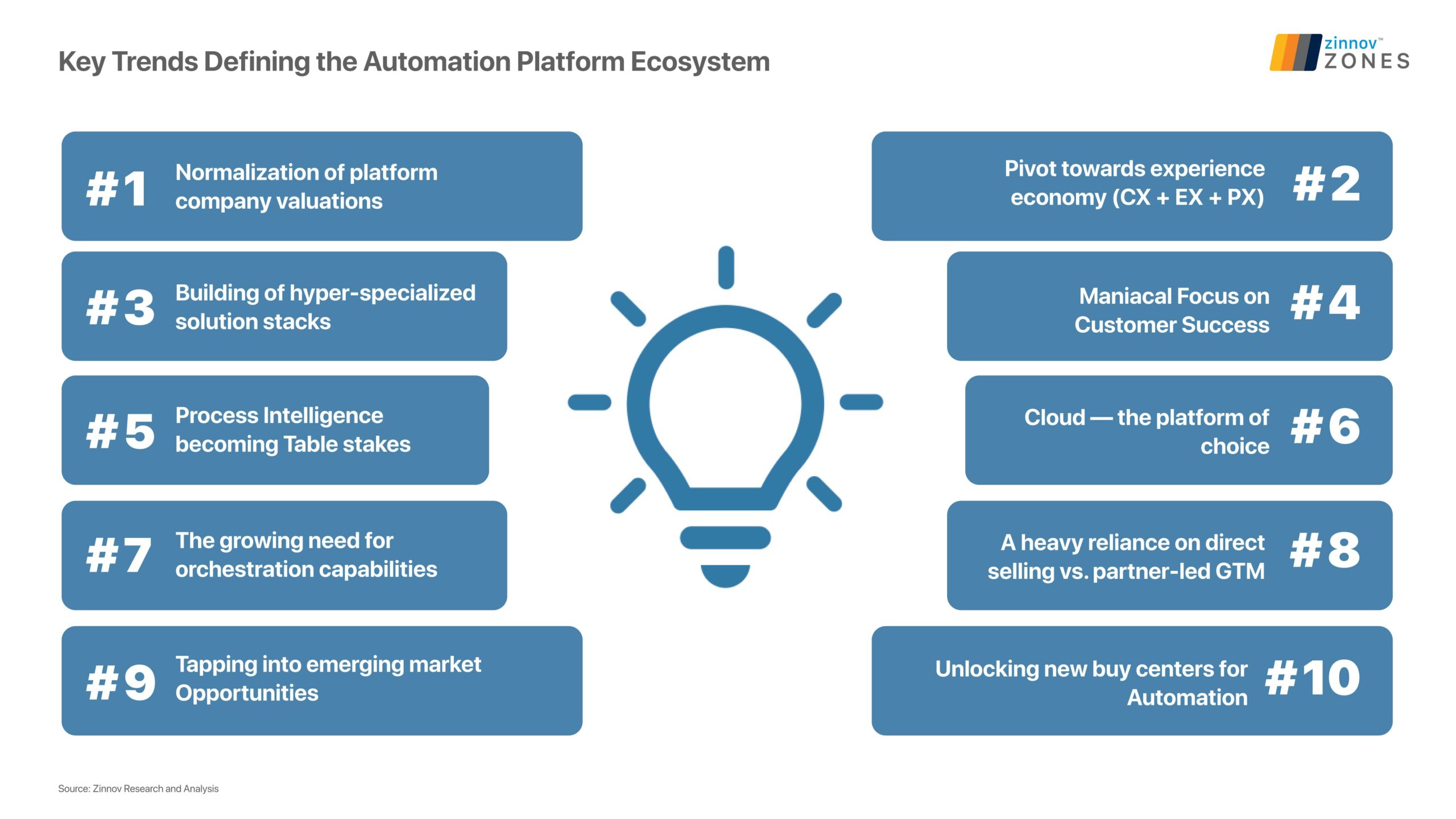|
|
The Automation industry has evolved considerably over the past couple of years. COVID led to an unprecedented surge in the adoption of Automation by enterprises in a bid to ensure business continuity and resiliency. Coming out of the pandemic, we see the enterprise customers shifting gears from being “desperate” to being a lot more “deliberate” in their approach to adopt Automation. Companies have become a lot more informed about the people, processes, and technology capabilities required to derive business value from Automation.
The definition of Automation itself has evolved quite significantly over the past several years. Enterprises today have multiple System of Record (SOR) applications, where they are looking at either enhancing critical SORs to make them more productive, or rapidly building new ones. At the same time enterprises are looking to make their SORs more integrated and intelligent creating Systems of Intelligence (SOI) to derive Decision Automation. They are further aiming to build interactive interfaces to power up their SOR or SOI to evolve into Systems of Experience (SOX) for a seamless customer, employee, and partner experience.

The full stack of Automation technologies is powering enterprises today at all the above-mentioned levels to ensure that enterprises are able to extract the maximum value from their SORs, SOIs, and SOXs for enhanced business outcomes.
The stack is powered by Artificial Intelligence (AI) enabled capabilities and next-gen infrastructure.
This holistic framework which is being adopted by enterprises today massively is what we are referring to as Intelligent Automation (IA). Today, IA is being leveraged to build scalable, resilient, differentiated, and efficiency-focused businesses.
Automation has a major role to play across these critical areas which will make it a true business and technology imperative in 2022.
Consequently, Automation today represents a sizeable market opportunity of USD 300 Bn+. We are at the tip of the iceberg with enterprises expected to spend a little over USD 20 Bn in 2022. However, we forecast immense potential in terms of a massive 50%+ growth over the next 5 years taking the annual enterprise spend to over USD 170 Bn. In addition, there are 1400+ platform players vying for a share of this action. This vibrant space has seen more than 50 acquisitions since 2021 and more than USD 17 Bn of VC/PE money has been poured into this fast-growing space.
“Zinnov Zones for Hyper Intelligent Automation – H1 2022” – the industry first, most comprehensive, and best-in-class assessment exercise for Automation platforms is aimed at gauging how equipped platforms are to cater to the rising demand for Automation by enterprises. We have exhaustively analyzed 90+ Automation platforms and specialist vendors on their technical prowess and scale of operations to identify the kingpins and visionaries. The study rates the players based on overall capabilities across the Automation lifecycle, with the platforms evaluated across 12 categories including Intelligent Automation, Process Intelligence, Intelligent Document Processing, RPA, Low Code/No Code Application Development, Intelligent Virtual Agent Orchestration, and industry-specific zones including, Banking and Financial Services, Insurance, Healthcare & Life Sciences, Retail & CPG, and Manufacturing.
In line with the changing paradigm of the Automation space and the evolving philosophy of HIA, 7 platforms have emerged as leaders in the overall HIA category – Nintex, UiPath, Kofax, Microsoft, Appian, SS&C (Blue Prism), and ServiceNow. These integrated platforms have showcased immense focus on building end-to-end capabilities across the Intelligent Automation stack to enable enterprise-wide deployment through consistent product innovation, strategic investments to expand market footprint and building ecosystems around their platforms.

Detailed HIA Platforms ratings across the 12 categories can be accessed on the Zinnov Zones website.
Based on our in-depth interactions with platform company CXOs, Enterprise Automation decision-makers, and Industry SMEs, there are 10 key trends that are shaping up the Automation platform ecosystem.

The valuations of most major public-traded Automation platform companies has fallen in the last 12-24 months, due to a variety of company-related factors such as continued financial losses, a slowdown in growth, and rising competition in the market as well as macro-economic factors such as an impending interest rate rise. Leading Automation platforms such as UiPath and Appian are currently trending at 9-12x Enterprise Value/Revenue multiples which are in line with major software companies like Microsoft (~11x).
Majority of companies are not just looking for cost savings through the automation of mundane tasks but striving for elevated business objectives around enhanced customer experience (CX), employee experience (EX), and partner experience (PX) to drive rapid business growth and market competitiveness. Platform companies are pivoting around these renewed enterprise expectations of building “Systems of Experience,” with platforms such as ServiceNow that have aligned its solution portfolio around business outcomes of customer experience, technology excellence, employee experience, and operating excellence.
75% of the top 35 automation platforms today have use-case specific solutions in their portfolio. Some of these platforms include companies like Olive AI that has a deep focus on one specific vertical, Healthcare, for instance. While there are others that are building industry or function-specific solution stacks through partnerships, developer-led approaches, in-house developments, or even acquisitions. For example, Kofax has a deep focus on AP (Accounts Payable) Automation and has already invested in 3 acquisitions for building depth in the use case.
There has been a rapid growth in the customer base for most of the platforms, with leading players having customers in excess of 10k. However, this has led to the platforms having a very transactional relationship with a long tail of customers. There is minimal focus on scaling customers and growing the average revenue per customer. Some of the leading platforms are now looking to unlock value from their top marquee accounts by investing in dedicated Customer Success programs for creating large deal opportunities, driving upsell/ cross-motions, and supporting customer automation programs in order to drive consumption and increase their wallet share.
The number of enterprises leveraging Process Intelligence technologies is expected to go up by over 60% in the next 2 years and there has been a blitzkrieg by automation platforms to acquire process mining, and task mining capabilities. Just this year alone we saw two of the leading HIA platforms make sizeable acquisitions to bolster their Process Intelligence prowess – Nintex (acquired Kryon Systems) and Microsoft (acquired Minit). In fact, there have been almost 15 acquisitions in this segment in the last 3 years.
Over 95% of the 100 leading automation platforms analyzed by Zinnov have initiated the shift towards adopting a Cloud-first approach in line with their customers’ preferences for the model. They are currently in different stages of this journey that typically takes multiple years, especially for incumbent platforms that have been in existence for 20-30 years. NICE Systems is a case in point, which has been able to successfully flip its model moving from only 22% SaaS subscription revenue 5 years ago to almost 90% in 2021.
The automation platform landscape for large enterprises is becoming increasingly complex with 70% of Fortune 250 enterprises today using multiple automation platforms. Automation platforms are aiding enterprises in managing these multi-vendor environments by providing orchestration capabilities either natively or through partnerships with specialist vendors. UiPath, for example, has partnered with multiple orchestration platforms such as Turbotic, ChoiceWORX, and Enate that allows customers in managing the entire Automation lifecycle (with multiple vendors) through a single platform.
Most companies in the automation platform ecosystem continue to rely largely on direct selling and only 30% of the major automation platforms are able to drive more than half their revenues through partners, compared to larger software companies such as Microsoft where more than 90% of revenue is partner driven. Platforms are looking to bolster their partner-led GTM through a multi-dimensional approach – onboarding of niche automation partners, investing in high-potential partners, setting up partner success organizations, and uplevelling alliance programs to ensure apt incentives and support for partners.
Traditionally platforms have been targeting North America and European regions for automation market opportunities given that the majority of the spending was focused on these geographies. However, given the fast-growing opportunity in APAC which is expected to account for 25% of the global market size in the next 5 years, leading platforms are doubling down in these markets. For example, Abbyy acquired Pericom, a Singapore-based company to expand its footprint in the Asia market.
Decision-making for Automation investments has been led by a line of business stakeholders traditionally. But with automation becoming more pervasive and strategic, IT leaders are jointly owning automation charters along with the business. Additionally, with business and corporate functions being consolidated into GBS (Global Business Services), there is a renewed focus on process reimagination and technology infusion. Automation platforms are targeting these new buy centers through focused messaging, thought leadership, building communities, leveraging industry forums, and dedicated sales teams in place.
The long-term winners in this space are not yet defined, with players continuing to invest deeply to make progress through both organic and inorganic means and capture a larger share of the enterprise spend. There are several market, business, and technology trends that are expected to shape the Automation space over the next 12-18 months. The space will witness immense technological evolution including the growing prominence of the convergence of Automation technologies and AI with humans at the center. There will be more scenarios where physical and digital automation will come together for end-to-end Process Automation, and enhanced business value. Newer tech such as Quantum Computing and Web3 is expected to come of age, and will play a bigger role in tandem with Automation Tech.